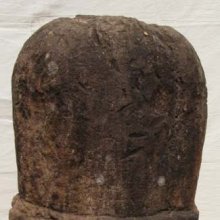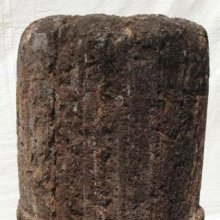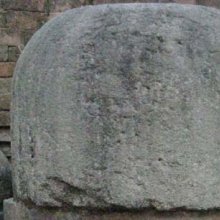Anda, Aṇḍa, Amda, Aṇḍā, Anḍā: 25 definitions
Introduction:
Anda means something in Buddhism, Pali, Hinduism, Sanskrit, Marathi, Jainism, Prakrit, Hindi, biology. If you want to know the exact meaning, history, etymology or English translation of this term then check out the descriptions on this page. Add your comment or reference to a book if you want to contribute to this summary article.
Images (photo gallery)
(+4 more images available)
In Hinduism
Purana and Itihasa (epic history)
Source: archive.org: Puranic EncyclopediaAṇḍa (अण्ड).—* Sūta, the disciple of Vyāsa said to the Munis at the Naimiśāraṇya about the creation of the Universe: In the beginning in the heavy universal darkness, the first seed of life (aṇḍa) appeared. (Mahābhārata, Ādi Parva, Chapter 1, Verse 28).
*) AṆḌA. The primal seed (Aṇḍa=egg or seed) from which everything was born.
Source: Cologne Digital Sanskrit Dictionaries: The Purana Index1a) Aṇḍa (अण्ड).—The egg shaped universe; the vyakta-rūpa of Viṣṇu described. See also puruṣa.*
- * Viṣṇu-purāṇa I. 2. 54-60.
1b) Beyond Āloka. Here are the seven continents and earth surrounded by a sea of clouds.1 The golden egglike aṇḍa emerges from Īśvara's seed and attains yoni (prakṛti), the latter being the embodiment of Nārāyaṇa, in a period of a thousand years. It became heaven and earth, ākāśa being in the middle.2 The outside is covered with waters ten times the aṇḍa— covered by tejas,—successively covered by vāyu, by ākāśa, this by bhūtādi; that by mahat and that in turn by avyakta each ten times the mass of its predecessor. These are the seven prakṛtis. avyakta is kṣetra and Brahmā ksetrajña.3 Brahmā born of.4 Like the moon in kumbha rāśi at the commencement of the śukla pakṣa; there are several aṇḍas, each covered by seven characteristics of prakṛti.5
- 1) Brahmāṇḍa-purāṇa I. 1. 43f; II. 19. 154-5, 160; 21. 24; III. 59. 27; IV. 2. 230-1.
- 2) Matsya-purāṇa 2. 29-32; 247. 43; 248. 1.
- 3) Vāyu-purāṇa 1. 50-52; 4. 82-9; 101. 227; Brahmāṇḍa-purāṇa I. 3. 26.
- 4) Vāyu-purāṇa 9. 122.
- 5) Vāyu-purāṇa 49. 147-51.

The Purana (पुराण, purāṇas) refers to Sanskrit literature preserving ancient India’s vast cultural history, including historical legends, religious ceremonies, various arts and sciences. The eighteen mahapuranas total over 400,000 shlokas (metrical couplets) and date to at least several centuries BCE.
Shaktism (Shakta philosophy)
Source: Google Books: ManthanabhairavatantramAṇḍa (अण्ड) refers to an “egg”, symbolizing the “microcosm” (i.e., the Egg of Brahmā—the universe that is projected into the body), according to Śitikaṇṭha’s Mahānayaprakāśa.—If (consciousness) abides in the Point (bindu) one can drink the nectar of the Moon located above. It is the light of the Abode of the Moon. Achieve repose by the unfolding of the microcosm (aṇḍa-vikāsa). This is the unique and special (quality) of the light of the Abode of the Sun. The digestion (of multiplicity) is the power of the gastric fire of the navel because, even though (this) Fire pervades the entire body, the Violent digestion (haṭhapāka) of diversity takes place in the belly.
Note: The word ‘aṇḍa’ literally means ‘egg’. Presumably, what is meant here is the Egg of Brahmā, i.e. the universe that is projected into the body.

Shakta (शाक्त, śākta) or Shaktism (śāktism) represents a tradition of Hinduism where the Goddess (Devi) is revered and worshipped. Shakta literature includes a range of scriptures, including various Agamas and Tantras, although its roots may be traced back to the Vedas.
Jyotisha (astronomy and astrology)
Source: Wisdom Library: Brihat Samhita by VarahamihiraAṇḍa (अण्ड) refers to an “egg”, according to the Bṛhatsaṃhitā (chapter 1), an encyclopedic Sanskrit work written by Varāhamihira mainly focusing on the science of ancient Indian astronomy astronomy (Jyotiṣa).—Accordingly, “[...] There was darkness (chaos) in the beginning. Then came water (into existence). On it (floated) a golden-coloured egg [i.e., aṇḍa], the (divine) seed consisting of the Earth and the Firmament from which there arose Brahmā, the creative agent with the sun and moon for his eyes. Kapila says that the universe had its origin in pradhāna; Kaṇātha in dravya and the like; a few in kāla (time); others in Svabhāva (nature); and some in karma. [...]”.

Jyotisha (ज्योतिष, jyotiṣa or jyotish) refers to ‘astronomy’ or “Vedic astrology” and represents the fifth of the six Vedangas (additional sciences to be studied along with the Vedas). Jyotisha concerns itself with the study and prediction of the movements of celestial bodies, in order to calculate the auspicious time for rituals and ceremonies.
Ayurveda (science of life)
Toxicology (Study and Treatment of poison)
Source: Shodhganga: Kasyapa Samhita—Text on Visha ChikitsaAṇḍa (अण्ड) refers to the “eggs (of snakes)”, as taught in the Nāgajanman (“birth of the Snakes”) section of the Kāśyapa Saṃhitā: an ancient Sanskrit text from the Pāñcarātra tradition dealing with both Tantra and Viṣacikitsā—an important topic from Āyurveda which deals with the study of Toxicology (Agadatantra or Sarpavidyā).—The female snakes conceive in the three months following Āṣāḍha month. After an incubation period of four months, tiny sarpas hatch from their eggs (aṇḍa) [tathāpyaṇḍān], measuring five aṅgulas, with red and black coloured heads. They are of three kinds: male, female and neuter.

Āyurveda (आयुर्वेद, ayurveda) is a branch of Indian science dealing with medicine, herbalism, taxology, anatomy, surgery, alchemy and related topics. Traditional practice of Āyurveda in ancient India dates back to at least the first millenium BC. Literature is commonly written in Sanskrit using various poetic metres.
In Buddhism
Mahayana (major branch of Buddhism)
Source: archive.org: Bulletin of the French School of the Far East (volume 5)Aṇḍa (अण्ड) [?] is the name of a Devaputra appointed as one of the Divine protector deities of Bālukā, according to chapter 17 of the Candragarbha: the 55th section of the Mahāsaṃnipāta-sūtra, a large compilation of Sūtras (texts) in Mahāyāna Buddhism partly available in Sanskrit, Tibetan and Chinese.—In the Candragarbhasūtra, the Bhagavat invites all classes of Gods and Deities to protect the Law [dharma?] and the faithful in their respective kingdoms of Jambudvīpa [e.g., the Devaputra Yang-tch'a (Aṇḍa ?) in Bālukā], resembling the time of the past Buddhas.
Source: De Gruyter: A Buddhist Ritual Manual on AgricultureAṇḍa (अण्ड) or Aṇḍaja refers to an “egg” (i.,e., ‘that which is egg-born’), according to the Vajratuṇḍasamayakalparāja, an ancient Buddhist ritual manual on agriculture from the 5th-century (or earlier), containing various instructions for the Sangha to provide agriculture-related services to laypeople including rain-making, weather control and crop protection.—Accordingly, [As the Bhagavān teaches an offering manual]: “[...] All crops, all flowers and fruits will be well protected. [...] Until the stake is driven out all kinds of pests, produced from moist heat, self-produced and egg-born (aṇḍaja), arisen from rocks or flowers, do not prevail. Harm of various sorts caused by Nāgas will not be victorious again. [...]”.

Mahayana (महायान, mahāyāna) is a major branch of Buddhism focusing on the path of a Bodhisattva (spiritual aspirants/ enlightened beings). Extant literature is vast and primarely composed in the Sanskrit language. There are many sūtras of which some of the earliest are the various Prajñāpāramitā sūtras.
Biology (plants and animals)
Source: Google Books: CRC World Dictionary (Regional names)1) Anda in French Guiana is the name of a plant defined with Joannesia princeps in various botanical sources. This page contains potential references in Ayurveda, modern medicine, and other folk traditions or local practices It has the synonym Anda gomesii A. Juss. (among others).
2) Anda in India is also identified with Nymphaea rubra It has the synonym Nymphaea rubra Roxb. ex Salisb..
3) Anda in Papua New Guinea is also identified with Ficus septica It has the synonym Ficus leucantatoma Poiret (etc.).
Example references for further research on medicinal uses or toxicity (see latin names for full list):
· De Euphorbiacearum Generibus Medicisque (1824)
· Flora Indica (1768)
· Fl. Flumin. (1829)
· Flora de Filipinas (1837)
· Phytochemistry (3327)
· Bol. Soc. Venez. Ci. Nat. (1940)
If you are looking for specific details regarding Anda, for example extract dosage, health benefits, diet and recipes, chemical composition, side effects, pregnancy safety, have a look at these references.

This sections includes definitions from the five kingdoms of living things: Animals, Plants, Fungi, Protists and Monera. It will include both the official binomial nomenclature (scientific names usually in Latin) as well as regional spellings and variants.
Languages of India and abroad
Pali-English dictionary
Source: BuddhaSasana: Concise Pali-English Dictionaryaṇḍa : (nt.) 1. an egg; 2. the testicles.
Source: Sutta: The Pali Text Society's Pali-English DictionaryAṇḍa, (nt.) (Etym. unknown. Cp. Sk. aṇḍa) 1. an egg Vin.III, 3; S.II, 258; M.I, 104; A.IV, 125 sq. — 2. (pl.) the testicles Vin.III, 106. — 3. (in camm°) a water-bag J.I, 249 (see Morris J. P. T. S. 1884, 69).

Pali is the language of the Tipiṭaka, which is the sacred canon of Theravāda Buddhism and contains much of the Buddha’s speech. Closeley related to Sanskrit, both languages are used interchangeably between religions.
Marathi-English dictionary
Source: DDSA: The Molesworth Marathi and English Dictionaryaṇḍa (अंड).—n (S) A testicle. 2 The musk bag regarded as the scrotum of the deer. 3 S An egg. See the derivative aṇḍēṃ. aṇḍa kāḍhaṇēṃ g. of o. To castrate or geld. aṇḍa khāja- viṇēṃ or aṇḍākhālīṃ khājaviṇēṃ g. of o. To court with exceeding servility and meanness. aṇḍa gāḷa- ṇēṃ To fail or miscarry; to fall short of one's vauntings. 2 To recede fearfully. aṇḍa brahmāṇḍāsa or kapāḷīṃ jāṇēṃ g. of s. To be in utter consternation and dismay. aṇḍa mhaṇajē umbaraphaḷa mhaṇaṇēṃ To be extraordinarily ignorant or unintelligent. aṇḍācēṃ nivaṇēṃ karuna basaṇēṃ or aṇḍāvara aṇḍa ghālūna basaṇēṃ To sit in complacent indolence or idleness. aṇḍāvara mūta gaḷaṇēṃ or paḍaṇēṃ g. of s. To be reduced to extreme debility and helplessness: also fig. to be contemptibly impotent or incompetent. aṇḍāsa yēṇēṃ To become heavy and infirm (from age &c.) aṇḍāsa lōṇī lāvaṇēṃ To cajole or wheedle; to delude by flattering. dusaṛyācyā aṇḍānēṃ viñcū māraṇēṃ To employ a person in one's own matters recklessly of his ruin or damage.
--- OR ---
āṇḍa (आंड).—See under अ.
Source: DDSA: The Aryabhusan school dictionary, Marathi-Englishaṇḍa (अंड).—n A testicle. An egg. aṇḍāsa lōṇī lāvaṇēṃ Cajole or wheedle, flatter.
--- OR ---
āṇḍa (आंड).—m A testicle.
Marathi is an Indo-European language having over 70 million native speakers people in (predominantly) Maharashtra India. Marathi, like many other Indo-Aryan languages, evolved from early forms of Prakrit, which itself is a subset of Sanskrit, one of the most ancient languages of the world.
Sanskrit dictionary
Source: DDSA: The practical Sanskrit-English dictionaryAṇḍa (अण्ड).—[amanti saṃprayogaṃ yānti anane; am-ḍa Uṇādi-sūtra 1. 111]
1) The testicles.
2) The scrotum.
3) An egg; oft. used with reference to the world as having sprung from the primordial, egg of Brahman; शब्दैरनेकैरशनिप्ररूढै- र्भिन्दन्निवाणुम् (śabdairanekairaśaniprarūḍhai- rbhindannivāṇum) Rām.5.54.33. ब्रह्माण्डच्छत्रदण्डः (brahmāṇḍacchatradaṇḍaḥ) Daśakumāracarita 1.
4) The musk bag.
5) semen virile.
6) Name of Śiva.
Derivable forms: aṇḍaḥ (अण्डः), aṇḍam (अण्डम्).
--- OR ---
Anda (अन्द).—Binding.
Derivable forms: andaḥ (अन्दः).
--- OR ---
Āṇḍa (आण्ड).—a. [aṇḍe bhavaḥ aṇ] Born from an egg (as a bird).
-ḍaḥ An epithet of Hiraṇyagarbha or Brahmā.
-ḍam 1 A multitude of eggs, brood.
2) Scrotum.
-ḍau (Ved.) The testicles. क्रोधो वृक्कौ मन्युराण्डौ प्रजा शेपः (krodho vṛkkau manyurāṇḍau prajā śepaḥ) Av.9.7.13.
Source: Cologne Digital Sanskrit Dictionaries: Shabda-Sagara Sanskrit-English DictionaryAṇḍa (अण्ड).—n.
(-ṇḍaṃ) 1. An egg. 2. A testicle or the scrotum. 3. Semen genitale. 4. The musk bag, regarded as the scrotum of the deer. E. ama to go, and ḍa Unadi aff.
--- OR ---
Āṇḍa (आण्ड).—n.
(-ṇḍaṃ) A multitude of eggs, &c. E. aṇḍa and aṇ aff.
Source: Cologne Digital Sanskrit Dictionaries: Benfey Sanskrit-English DictionaryAṇḍa (अण्ड).—n. 1. An egg. 2. A testicle.
Source: Cologne Digital Sanskrit Dictionaries: Cappeller Sanskrit-English DictionaryAṇḍa (अण्ड).—[neuter] egg, testicle; gata [adjective] being in the egg.
--- OR ---
Āṇḍa (आण्ड).—[neuter] egg; [masculine] [dual] the testicles; [feminine] ī a t.
Source: Cologne Digital Sanskrit Dictionaries: Monier-Williams Sanskrit-English Dictionary1) Aṇḍa (अण्ड):—n. (also m., [cf. Lexicographers, esp. such as amarasiṃha, halāyudha, hemacandra, etc.]) ([√am, [Uṇādi-sūtra]]), an egg, a testicle
2) the scrotum
3) the musk bag
4) semen virile, [cf. Lexicographers, esp. such as amarasiṃha, halāyudha, hemacandra, etc.]
5) Name of Śiva (from his being identified with the Brahmāṇḍa or mundane egg).
6) a pinnacle or cupola, [Varāha-mihira’s Bṛhat-saṃhitā]
7) a [particular] part of a Stūpa, [Divyāvadāna]
8) a sword with irregular longitudinal white marks, [cf. Lexicographers, esp. such as amarasiṃha, halāyudha, hemacandra, etc.]
9) Āṇḍa (आण्ड):—n. ([from] aṇḍa), an egg, [Ṛg-veda; Atharva-veda] etc.
10) m. [dual number] (au) the testicles, [Atharva-veda ix, 7, 13; Vājasaneyi-saṃhitā] etc.
11) Ānda (आन्द):—m. (√and [commentator or commentary] on [Vājasaneyi-saṃhitā xxx, 16]), one who makes fetters, [Vājasaneyi-saṃhitā]
Source: Cologne Digital Sanskrit Dictionaries: Goldstücker Sanskrit-English DictionaryAṇḍa (अण्ड):—m. n.
(-ṇḍaḥ-ṇḍam) 1) An egg.
2) A testicle.
3) The scro-tum.
4) Semen genitale.
5) The musk bag, regarded as the scrotum of the deer.
6) A name or epithet of Śiva (from his being compared to the Brahmānḍa or representing the world). E. am, uṇ. aff. ḍa.
--- OR ---
Anda (अन्द):—1. m.
(-ndaḥ) Binding. 2. f.
(-ndā) Perhaps the same as andikā. (Both forms given on the authority of Hemachandra’s Dhātuparāyaṇa; their real occurence is doubtful.) E. and, kṛt aff. ac. See the Preface.
Source: Cologne Digital Sanskrit Dictionaries: Yates Sanskrit-English Dictionary1) Aṇḍa (अण्ड):—(ṇḍaṃ) 1. n. An egg.
2) Āṇḍa (आण्ड):—(ṇḍaṃ) 1. n. Multitude of eggs.
Source: DDSA: Paia-sadda-mahannavo; a comprehensive Prakrit Hindi dictionary (S)Aṇḍa (अण्ड) in the Sanskrit language is related to the Prakrit words: Aṃḍa, Aṃḍaa, Aṃḍaga.
[Sanskrit to German]
Sanskrit, also spelled संस्कृतम् (saṃskṛtam), is an ancient language of India commonly seen as the grandmother of the Indo-European language family (even English!). Closely allied with Prakrit and Pali, Sanskrit is more exhaustive in both grammar and terms and has the most extensive collection of literature in the world, greatly surpassing its sister-languages Greek and Latin.
Hindi dictionary
Source: DDSA: A practical Hindi-English dictionaryAnda in Hindi refers in English to:—(nm) an egg; [amde-bacce] the offspring; [amde ki khatira murgi halala karana] to kill the hen that lays the golden eggs; [amde sena] to hatch, to incubate; to sit idle..—anda (अंडा) is alternatively transliterated as Aṃḍā.
...
Prakrit-English dictionary
Source: DDSA: Paia-sadda-mahannavo; a comprehensive Prakrit Hindi dictionary1) Aṃḍa (अंड) in the Prakrit language is related to the Sanskrit word: Aṇḍa.
Aṃḍa has the following synonyms: Aṃḍaa, Aṃḍaga.
2) Aṃda (अंद) also relates to the Sanskrit word: Candra.
Prakrit is an ancient language closely associated with both Pali and Sanskrit. Jain literature is often composed in this language or sub-dialects, such as the Agamas and their commentaries which are written in Ardhamagadhi and Maharashtri Prakrit. The earliest extant texts can be dated to as early as the 4th century BCE although core portions might be older.
Kannada-English dictionary
Source: Alar: Kannada-English corpusAṃḍa (ಅಂಡ):—
1) [noun] one who shoots with a bow and arrows; an archer.
2) [noun] a man engaged in military services; a soldier.
--- OR ---
Aṃḍa (ಅಂಡ):—
1) [noun] an oval body laid by birds and certain animals from which the young is hatched; an egg.
2) [noun] a male reproductive gland; the testicle.
3) [noun] the bag that contains the testicles; the scrotum.
4) [noun] a skin-pin in musk-deer, producing musk; musk-gland.
5) [noun] the liquid that covers spermatozoa; the semen.
6) [noun] Śiva, one of the Hindu Trinities.
7) [noun] the world a) the entire earth; the earth planet; b) the whole universe.
--- OR ---
Aṃda (ಅಂದ):—
1) [noun] the quality that pleases the sight; beauty; grace; charm.
2) [noun] the way, manner, a thing is to be done etc.
3) [noun] likeness; similarity.
4) [noun] idea or aim kept for an effort; purpose.
5) [noun] the state or condition of being.
6) [noun] the essential quality that makes a thing what it is; nature.
7) [noun] ಅಂದಚಂದ [amdacamda] anda canda beauty; ಅಂದನೋಡಿ ಅರೆದುಕೊಂಡು ಕುಡಿ, ಗುಣನೋಡಿ ಗುದ್ದಿ ಕೊಂಡು ಸಾಯಿ [amdanodi aredukomdu kudi, gunanodi guddi komdu sayi] anda nōḍi aredukoṇḍu kuḍi, guṇa nōdi guddikoṇḍu sāyi (prov.) a person’s character must weigh more than the beauty; ಅಂದಚಂದಕೆ ನಾನು, ರಾಗ ರಚನೆಗೆ ನಮ್ಮಕ್ಕ [amdacamdake nanu, raga racanege nammakka] andachandake nānu, rāgaracanege nammakka (prov.) beauty is here, for utility see elsewhere.
--- OR ---
Āṃḍa (ಆಂಡ):—[noun] name of an ardent devotee of Śiva.
Kannada is a Dravidian language (as opposed to the Indo-European language family) mainly spoken in the southwestern region of India.
See also (Relevant definitions)
Starts with (+215): Amdaa, Amdabamda, Amdadarbaru, Amdade, Amdadhari, Amdadumdi, Amdaga, Amdaga, Amdagara, Amdagarike, Amdagarti, Amdagati, Amdage, Amdagedi, Amdagedisu, Amdagedu, Amdagey, Amdagolisu, Amdagollu, Amdaisu.
Ends with (+2764): Aaru moole kaanda, Aaru-moole-kaanda, Aattuparanda, Abanda, Abaraskanda, Abhaktacchanda, Abhaktachchhanda, Abhanda, Abhandakubhanda, Abhayananda, Abhicamda, Abhigamadanda, Abhigamanadanda, Abhikranda, Abhinanda, Abhinishyanda, Abhisanda, Abhishyanda, Abhiskanda, Abhivamda.
Full-text (+193): Andakosha, Amdaga, Andalu, Andira, Andaka, Andaja, Andavardhana, Andakataha, Putyanda, Andadhara, Adhyanda, Andayana, Andasu, Andavriddhi, Jalandaka, Kukkutanda, Andakoshaka, Amdaa, Andakotarapushpi, Andakarshana.
Relevant text
Search found 55 books and stories containing Anda, Aṇḍa, Amda, Aṇḍā, Anḍā, Āṇḍa, Ānda, Aṃḍa, Aṃda, Āṃḍa; (plurals include: Andas, Aṇḍas, Amdas, Aṇḍās, Anḍās, Āṇḍas, Āndas, Aṃḍas, Aṃdas, Āṃḍas). You can also click to the full overview containing English textual excerpts. Below are direct links for the most relevant articles:
Garga Samhita (English) (by Danavir Goswami)
Verse 1.2.25 < [Chapter 2 - Description of the Abode of Śrī Goloka]
Verse 1.2.26 < [Chapter 2 - Description of the Abode of Śrī Goloka]
Verse 2.12.18 < [Chapter 12 - Subduing Kāliya and Drinking the Forest Fire]
Chandogya Upanishad (Shankara Bhashya) (by Ganganatha Jha)
Section 3.19 (nineteenth khaṇḍa) (four texts) < [Chapter 3 - Third Adhyāya]
Historical Elements in the Matsya Purana (by Chaitali Kadia)
Subject matter of the Purāṇas < [Chapter 1 - An Introduction of the Purāṇas]
Stupas in Orissa (Study) (by Meenakshi Chauley)
The Anda Portion (of the Stupa) < [Chapter 4]
Minor Votive Stupas at Lalitagiri < [Chapter 4]
Minor Votive Stupas at Udayagiri < [Chapter 4]
Chandogya Upanishad (Madhva commentary) (by Srisa Chandra Vasu)
Brihat Samhita (by N. Chidambaram Iyer)
Related products







